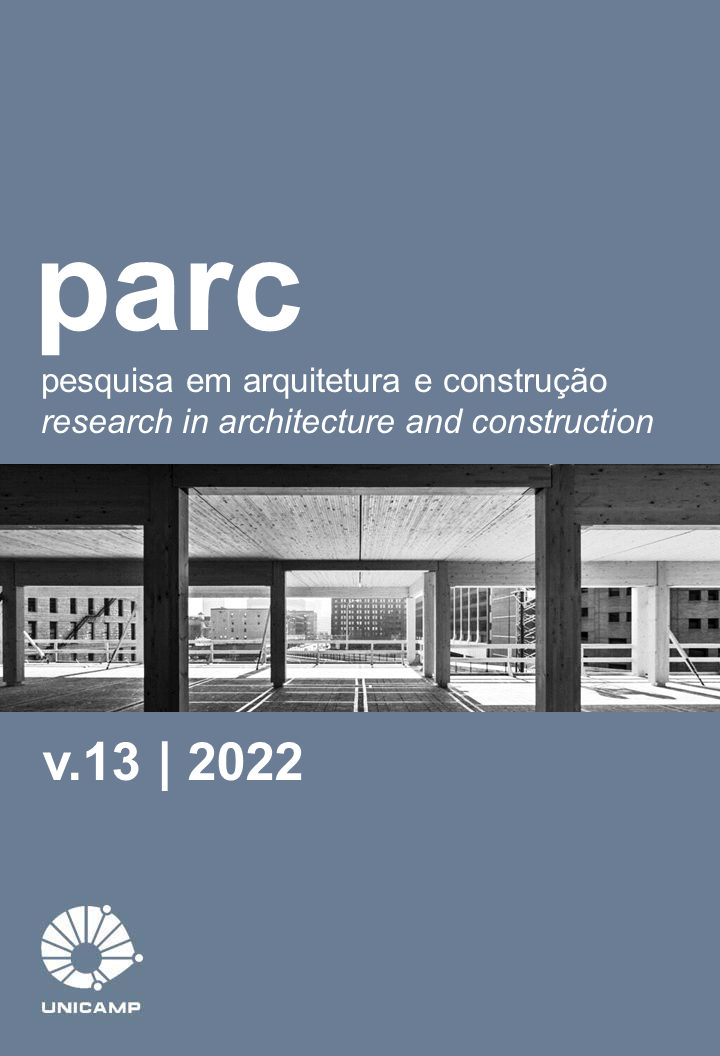Abstract
Among bioclimatic strategies, the use of vegetation has taken on a major role due to its effectiveness in reducing surface and indoor environmental temperatures and, consequently, reducing building energy consumption. In this context, this work shows the results of a study whose objective was to identify the contribution of green facades - vertical garden typology that uses climbing plant species - in the thermal performance of working environments in hot weather conditions. To this end, an experimental study was carried out on a university campus in Ourinhos-SP, a city with a subtropical climate and hot summer, by implementing a green facade on the west facade of a university office, built of concrete blocks and metal roofing. The study included the implementation of a green facade with the climbing plant Ipomoea horsfalliae Hook; microclimatic measurements (air temperature, relative humidity and air speed inside and outside the offices) in the office protected by the green facade and in a similar one (in size and orientation), which served as a control (without green facade). The analysis of the results shows the potential thermal mitigation of the green facade since the average air temperature of the office with the presence of this strategy showed an average reduction of 4.4 ° C to the control environment.
References
ALEXANDRI, E.; JONES, P. Temperature decreases in an urban canyon due to green walls and green roofs in diverse climates. Building and Environment, v. 43, n. 4, p. 480–493, abr. 2008. DOI: https://doi.org/10.1016/j.buildenv.2006.10.055
ALVARES, C. A. et al. Köppen’s Climate Classification Map for Brazil. Meteorologische Zeitschrift, v. 22, n. 6, p. 711–728, 1 dez. 2013. DOI: https://doi.org/10.1127/0941-2948/2013/0507
ASSOCIAÇÃO BRASILEIRA DE NORMAS TÉCNICAS. NBR 15220-3: Desempenho térmico das edificações: Parte 3-Zoneamento bioclimático brasileiro e diretrizes construtivas para edificações unifamiliares de interesse social. Rio de Janeiro. 2005.
BARBOSA, M. C.; FONTES, M. S. G. de C. Jardins verticais: modelos e técnicas. PARC Pesquisa em Arquitetura e Construção, Campinas, SP, v. 7, n. 2, p. 114–124, 2016. DOI: https://doi.org/10.20396/parc.v7i2.8646304.
CAMERON, R. W. F.; TAYLOR, J.; EMMETT, M. A Hedera Green Façade – Energy Performance and Saving under Different Maritime-Temperate, Winter Weather Conditions. Building and Environment, v. 92, p. 111–121, out. 2015. DOI: https://doi.org/10.1016/j.buildenv.2015.04.011
CHENG, C. Y.; CHEUNG, K. K. S.; CHU, L. M. Thermal Performance of a Vegetated Cladding System on Facade Walls. Building and Environment, v. 45, n. 8, p. 1779–1787, ago. 2010. DOI: https://doi.org/10.1016/j.buildenv.2010.02.005
EUMORFOPOULOU, E. A.; KONTOLEON, K. J. Experimental Approach to the Contribution of Plant-Covered Walls to the Thermal Behaviour of Building Envelopes. Building and Environment, v. 44, n. 5, p. 1024–1038, maio 2009.
ISO – INTERNACIONAL ORGANIZATION OF STANDARDIZATION. ISO 77726. Ergonomics of the Thermal Environment-Instruments for measuring physical Quantities. International Organization for Standardization, Geneva. 1998
KÖHLER, M. Green Facades—a View Back and Some Visions. Urban Ecosystems, v. 11, n. 4, p. 423–436, dez. 2008.
MANSO, M.; CASTRO-GOMES, J. Green Wall Systems: A Review of Their Characteristics. Renewable and Sustainable Energy Reviews, v. 41, p. 863–871, jan. 2015. DOI: https://doi.org/10.1016/j.rser.2014.07.203
MORELLI, D.; LABAKI, L. C. Paredes verdes: estudo experimental sobre seus efeitos no espaço construído. In: ENCONTRO NACIONAL DE CONFORTO NO AMBIENTE CONSTRUÍDO, 12.; ENCONTRO LATINO-AMERICANO DE CONFORTO NO AMBIENTE CONSTRUÍDO, 8., 2013, Brasília. Anais [...]. Brasília: ENCAC-ELACAC, 2013.
MUÑOZ, L. S. Potencial amenizador térmico de jardim vertical do tipo fachada verde indireta: estudos com diferentes espécies de trepadeiras. 2019. Dissertação (Mestrado em Arquitetura e Urbanismo) - Universidade Estadual Paulista, Bauru, 2019. Disponível em: http://hdl.handle.net/11449/190836. Acesso em: 19 dez. 2021.
MUÑOZ, L. S.; CRUCIOL BARBOSA, M.; FONTES, M. S. G. de C.; FARIA, J. R. G. de. Desempenho térmico de jardins verticais de tipologia fachada verde. PARC Pesquisa em Arquitetura e Construção, Campinas, SP, v. 10, p. e019013, 2019. DOI: https://doi.org/10.20396/parc.v10i0.8652775.
OTTELÉ, M. et al. Comparative Life Cycle Analysis for Green Façades and Living Wall Systems. Energy and Buildings, v. 43, n. 12, p. 3419–3429, dez. 2011. DOI: https://doi.org/10.1016/j.enbuild.2011.09.010
PAPADAKIS, et al. An experimental investigation of the effect of shading with plants for solar control of buildings. Energy and Buildings. v. 33 p. 831.836. out. 2001. DOI: https://doi.org/10.1016/S0378-7788(01)00066-4
PÉREZ, G. et al. Green Facade for Energy Savings in Buildings: The Influence of Leaf Area Index and Facade Orientation on the Shadow Effect. Applied Energy, v. 187, p. 424–437, fev. 2017. DOI: https://doi.org/10.1016/j.apenergy.2016.11.055
PROJETEEE – Projetando Edificações Energeticamente Eficientes. Componentes construtivos. Disponível em: http://projeteee.mma.gov.br/componente/bloco-concreto-14x19x39-cm-argamassa-externa-2-5-cm/. Acesso em: 25 jun. 2020.
PROJETEE - Projetando Edificações Energeticamente Eficientes. Dados climáticos de Ourinhos-SP, INMET 2016. Disponível em: http://projeteee.mma.gov.br/dadosclimaticos/?cidade=SP++Ourinhos&id_cidade=bra_sp_ournhos.868660_inmet. Acesso em: 20 jun. 2020.
RAMALHO, C. L. Trepadeiras Ornamentais do Cerrado. 1a ed. Brasilia-DF: Embrapa Cerrados, 2004. v. 1o
SAFIKHANI, T. et al. Thermal Impacts of Vertical Greenery Systems. Environmental and Climate Technologies, v. 14, n. 1, p. 5-11, 2015. DOI: https://doi.org/10.1515/rtuect-2014-0007
SCHERER, M. J.; FEDRIZZI, B. M. Jardins verticais: potencialidades para o ambiente urbano. Revista Latino-Americana de Inovação e Engenharia de Produção, v. 2, n. 2, p. 49-61, 2014.
SOUSA, R. B. de. Jardins Verticais: um contributo para os espaços verdes urbanos e oportunidade na reabilitação do edificado. 2012. Dissertação (Mestrado em Arquitetura) – Faculdade de Arquitetura, Universidade Lusófona do Porto, Porto, 2012.
SUNAKORN, P.; YIMPRAYOON, C. Thermal Performance of Biofacade with Natural Ventilation in the Tropical Climate. Procedia Engineering, v. 21, p. 34–41, 2011. DOI: https://doi.org/10.1016/j.proeng.2011.11.1984
SUSOROVA, I.; AZIMI, P.; STEPHENS, B. The Effects of Climbing Vegetation on the Local Microclimate, Thermal Performance, and Air Infiltration of Four Building Facade Orientations. Building and Environment, v. 76, p. 113–124, jun. 2014. DOI: http://dx.doi.org/10.1016%2Fj.buildenv.2014.03.011
YANG, F. et al. Summertime Thermal and Energy Performance of a Double-Skin Green Facade: A Case Study in Shanghai. Sustainable Cities and Society, v. 39, p. 43–51, mai. 2018. DOI: https://doi.org/10.1016/j.scs.2018.01.049

This work is licensed under a Creative Commons Attribution 4.0 International License.
Copyright (c) 2022 PARC Pesquisa em Arquitetura e Construção


